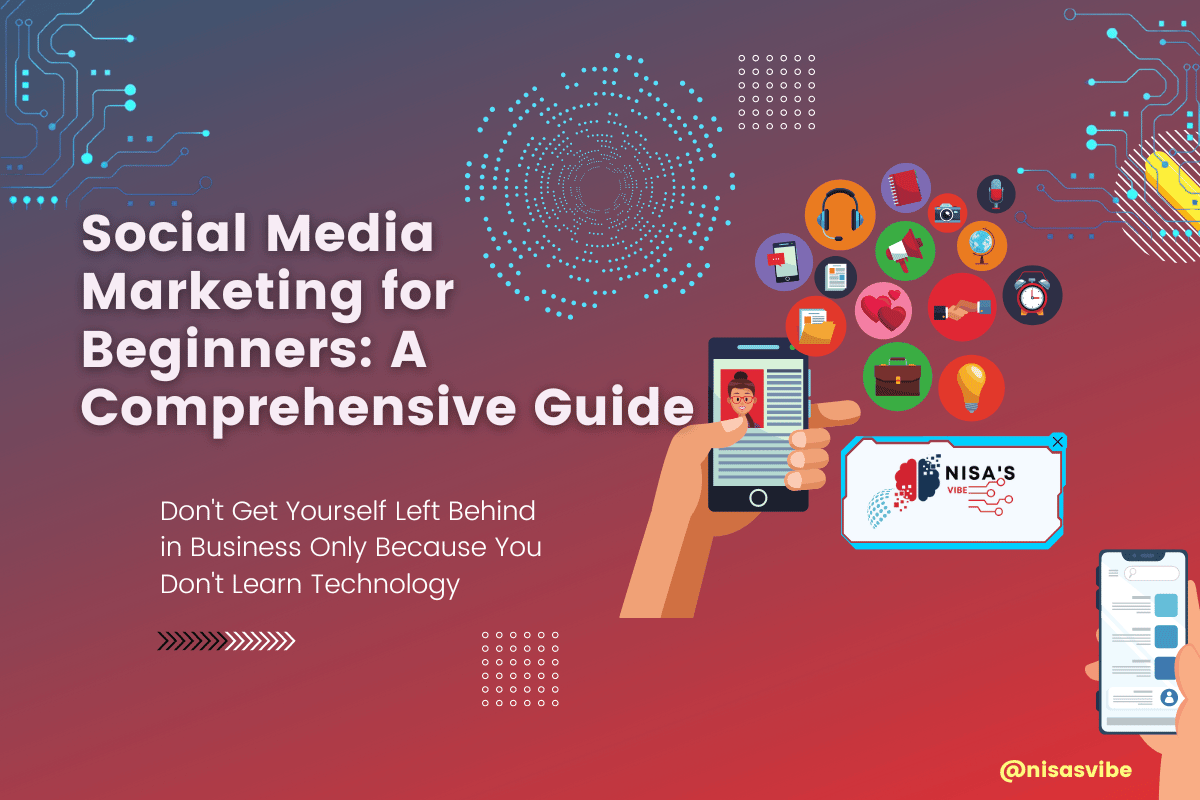Hi, I’m Nisa! As a digital marketer, I’ve worked with businesses of all sizes to help them harness the power of social media marketing. In 2025, social media is more important than ever for building brand awareness, driving traffic, and increasing sales. If you’re a beginner looking to start your journey in social media marketing, this proven guide will provide you with the essential strategies, tips, and tools you need to succeed.
1. Understand the Importance of Social Media Marketing
Before diving into the how-to’s, it’s important to understand why social media marketing matters. Social media platforms are where people spend a significant amount of time. As a business, you need to leverage these platforms to build relationships, create content, and engage with your target audience.
Why it matters:
- Build brand awareness: Social media provides an excellent platform for showcasing your brand to a large, targeted audience.
- Increase engagement: Interacting with followers, responding to comments, and sharing valuable content help strengthen relationships with potential customers.
- Drive traffic and sales: Social media can directly lead to conversions, whether it’s making a purchase, signing up for a newsletter, or visiting your website.
2. Choose the Right Social Media Platforms
There are dozens of social media platforms out there, but not all of them are right for your business. Choosing the right platforms is critical to the success of your social media marketing strategy.
Why it matters:
- Different platforms attract different demographics and types of content. For example, Instagram is highly visual, while LinkedIn is best for B2B marketing.
- You’ll want to focus on platforms that align with your business goals, target audience, and the type of content you plan to create.
Popular social media platforms for businesses:
- Facebook: Great for building a community, running targeted ads, and sharing a variety of content (photos, videos, articles).
- Instagram: Ideal for visual storytelling, product promotions, and influencer collaborations.
- Twitter: Perfect for real-time updates, engaging in conversations, and sharing news or trends.
- LinkedIn: Best for B2B marketing, networking, and thought leadership.
- TikTok: A fast-growing platform that works well for creative, short-form videos aimed at younger audiences.
- Pinterest: Excellent for businesses in fashion, home décor, beauty, and lifestyle.
Tips for choosing the right platform:
- Research your audience: Understand where your target audience spends most of their time.
- Focus on a few platforms: It’s better to master a few platforms rather than spread yourself too thin.
3. Create a Social Media Strategy
Once you’ve chosen your platforms, it’s time to develop a clear social media marketing strategy. This strategy will guide your content creation, help you stay consistent, and ensure you’re aligned with your overall business goals.
Why it matters:
- A strategy ensures that your efforts are organized and targeted.
- It helps you define content types, posting schedules, and engagement tactics, making it easier to measure success.
Key components of a social media strategy:
- Set clear goals: Do you want to increase brand awareness, drive traffic, or generate leads? Your goals will guide your content and actions.
- Identify your target audience: Know your audience’s age, gender, interests, location, and social media behavior to create content that resonates.
- Create a content calendar: Plan your posts in advance to maintain consistency and organize your content by month, week, or day.
- Measure success: Use KPIs (Key Performance Indicators) like engagement rate, reach, conversions, and traffic to evaluate the effectiveness of your strategy.
4. Create Engaging and Valuable Content
Content is the heart of social media marketing. To stand out and engage your audience, your content needs to be valuable, relevant, and shareable.
Why it matters:
- Engaging content drives interaction, which increases visibility and encourages followers to share your posts.
- Valuable content provides solutions, answers questions, or entertains your audience, building trust and authority for your brand.
Types of content to create:
- Images and graphics: Share eye-catching visuals that resonate with your audience. Use tools like Canva to create stunning graphics.
- Videos: Videos are highly engaging and can range from product demos to behind-the-scenes footage or tutorials.
- Blog posts: Share your blog content on social media to drive traffic back to your website.
- User-generated content (UGC): Encourage customers to share photos or testimonials, which helps build trust with your audience.
- Polls, quizzes, and interactive posts: Engage your followers by asking questions, running polls, or hosting interactive contests.
Tips for creating engaging content:
- Keep it visually appealing: Use high-quality images and videos.
- Use a clear call-to-action (CTA): Encourage your audience to take the next step, whether it’s visiting your website, signing up for a newsletter, or making a purchase.
- Maintain consistency: Your brand voice should be consistent across all platforms, ensuring recognition and trust.
5. Engage with Your Audience
Social media is all about building relationships, and engagement is key. Don’t just post content and forget about it—interact with your audience, respond to comments, and create a two-way conversation.
Why it matters:
- Engagement helps build a loyal community, improving customer retention and word-of-mouth marketing.
- It allows you to understand your audience better, receive feedback, and adapt your strategy accordingly.
Tips for engaging with your audience:
- Respond to comments: Show your audience that you value their input by responding to questions and comments.
- Run giveaways or contests: Encourage participation and increase engagement by offering prizes in exchange for likes, shares, or comments.
- Use polls and surveys: Ask questions to get direct feedback from your followers about your products or services.
6. Analyze and Optimize Your Performance
To improve your social media marketing efforts, you must regularly measure and analyze your performance. Analytics provide insights into what’s working, what’s not, and where you can improve.
Why it matters:
- Tracking performance allows you to adjust your strategy to get better results.
- It helps you understand which platforms and content types are most effective at achieving your goals.
Key social media metrics to track:
- Engagement rate: Measures how much your audience interacts with your content (likes, comments, shares).
- Reach and impressions: Track how many people see your content and how often they see it.
- Click-through rate (CTR): Measures how many people click on your links.
- Conversions: Track how many people complete a desired action (like making a purchase or signing up for a newsletter).
- Follower growth: Measure how quickly your followers are increasing on each platform.
Tools for tracking performance:
- Google Analytics: Track traffic and conversions driven by social media.
- Social media insights: Each platform (Facebook, Instagram, Twitter) provides its own analytics to monitor your performance.
- Third-party tools: Platforms like Hootsuite, Buffer, and Sprout Social help manage and track social media campaigns across multiple platforms.
7. Paid Social Advertising for Accelerated Growth
While organic social media efforts are effective, paid advertising can amplify your reach and speed up growth. Facebook Ads, Instagram Ads, and LinkedIn Ads offer businesses the opportunity to target highly specific demographics and increase visibility.
Why it matters:
- Paid ads provide faster results and allow you to target exactly the audience you want to reach.
- Social media ads are cost-effective, with flexible budgeting options, making them accessible for businesses of all sizes.
How to run successful paid ads:
- Define your target audience: Use demographic information such as age, interests, location, and behaviors to target your ideal customers.
- Set clear objectives: Whether you want to increase brand awareness, drive traffic, or generate leads, set clear goals for your ad campaigns.
- Test and optimize: Run A/B tests on different ad creatives, targeting options, and formats to determine what works best.
Master Social Media Marketing for Success
Social media marketing offers startups and businesses the opportunity to grow their audience, increase brand awareness, and drive sales. By following the strategies outlined in this guide, you’ll be able to create a comprehensive social media plan that aligns with your business goals, engages your audience, and delivers measurable results.
Stay consistent, track your performance, and adapt as needed to ensure your social media efforts continue to produce long-term success.
FAQ
Here are some frequently asked questions about social media marketing for beginners:
Q. How often should I post on social media?
A. The frequency of social media posting will depend on your business and your audience, but aim for at least one post per day on each platform.
Q. How do I know which social media platforms are right for my business?
A. Consider your target audience and the type of content you want to share when choosing social media platforms for your business.
Social media marketing is a powerful tool for businesses looking to connect with their target audience and drive sales. By understanding social media platforms, developing a social media strategy, creating engaging content, building a following, analyzing and measuring results, using paid social media advertising, leveraging social media management tools, and avoiding common mistakes, businesses can create a successful social media marketing campaign and achieve their goals. So start building your social media presence today and watch your business grow.




